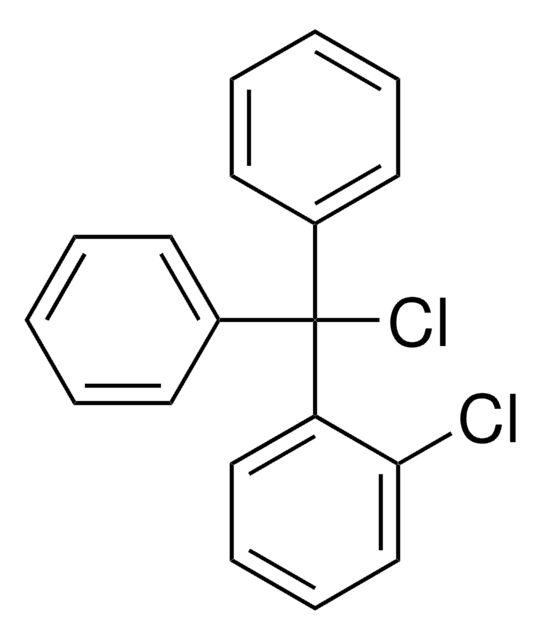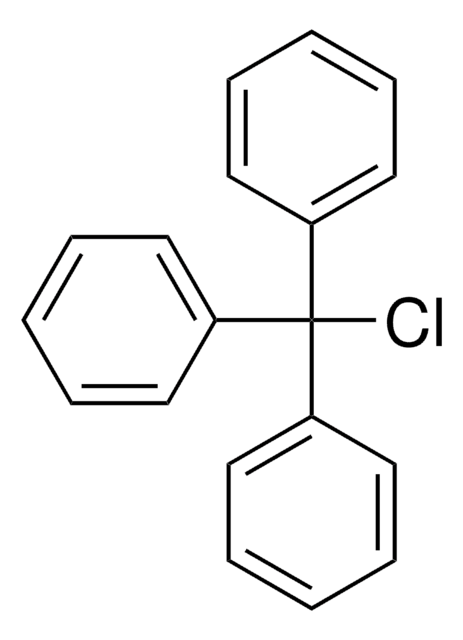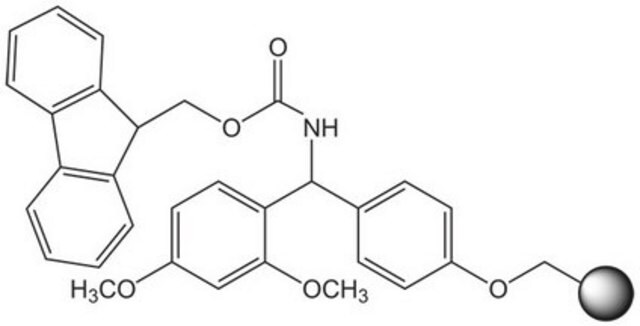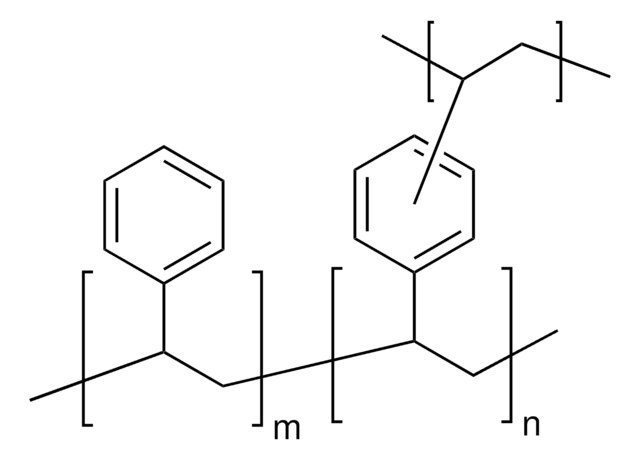Kluczowe dokumenty
532290
2-Chlorotrityl chloride, polymer-bound
200-400 mesh, extent of labeling: 1.0-1.5 mmol/g Cl loading, 1 % cross-linked
Synonim(y):
2,α-Dichlorobenzhydryl-polystyrene crosslinked with divinylbenzene
About This Item
Polecane produkty
Poziom jakości
sieciowanie krzyżowe
1 % cross-linked
przydatność reakcji
reaction type: Fmoc solid-phase peptide synthesis
zakres etykietowania
1.0-1.5 mmol/g Cl loading
wielkość cząstki
200-400 mesh
Zastosowanie
peptide synthesis
ciąg SMILES
Clc1ccccc1C(Cl)(c2ccccc2)c3ccccc3
InChI
1S/C19H14Cl2/c20-18-14-8-7-13-17(18)19(21,15-9-3-1-4-10-15)16-11-5-2-6-12-16/h1-14H
Klucz InChI
JFLSOKIMYBSASW-UHFFFAOYSA-N
Szukasz podobnych produktów? Odwiedź Przewodnik dotyczący porównywania produktów
Powiązane kategorie
Zastosowanie
- Żywica labilna kwasowo stosowana w syntezie peptydów w fazie stałej opartej na Fmoc.
- Łagodne kwasowe warunki rozszczepiania prowadzą do uwolnienia kwasu peptydowego, przy czym w razie potrzeby można uwolnić w pełni chronione peptydy.
- Żywice chlorku 2-chlorotrytylu zapobiegają racemizacji pierwszego aminokwasu i dlatego są bardzo przydatne, gdy tworzą się mieszaniny racemiczne (powszechne w przypadku reszt takich jak His lub Cys).
- Żywica ta zapobiega również tworzeniu się diketopiperazydu, co może być problemem w przypadku prolinowych C-końcowych sekwencji peptydowych.
Zastosowanie:
- Przyłączenie pierwszej reszty aminokwasowej odbywa się poprzez mieszanie żywicy, chronionego aminokwasu i nadmiaru diizopropyloetyloaminy (DIEA) w dichlorometanie.
- Rozszczepienie końcowego chronionego fragmentu peptydu uzyskuje się w bardzo łagodnych warunkach przy użyciu kwasu octowego / trifluoroetanolu (TFE) / dichlorometanu (1: 1: 8; v / v / v), heksafluoroizopropanolu (HFIP) / dichlorometanu (1: 4; v / v) lub po prostu 0,5% kwasu trifluorooctowego / dichlorometanu (v / v).
- Wyższe stężenia TFA mogą być stosowane, jeśli zatrzymanie grup zabezpieczających łańcuch boczny peptydu jest nieistotne. Należy pamiętać, że chlorek tritylu jest wrażliwy na wilgoć i dlatego powinien być odpowiednio przechowywany i obsługiwany.
- Jeśli żywica ulegnie dezaktywacji, przed użyciem zaleca się potraktowanie chlorkiem acetylu lub SOCl2 w toluenie w celu przywrócenia jej aktywności.
Hasło ostrzegawcze
Warning
Zwroty wskazujące rodzaj zagrożenia
Zwroty wskazujące środki ostrożności
Klasyfikacja zagrożeń
Eye Irrit. 2 - Met. Corr. 1 - Skin Irrit. 2 - STOT SE 3
Organy docelowe
Respiratory system
Kod klasy składowania
8A - Combustible corrosive hazardous materials
Klasa zagrożenia wodnego (WGK)
WGK 3
Temperatura zapłonu (°F)
Not applicable
Temperatura zapłonu (°C)
Not applicable
Środki ochrony indywidualnej
dust mask type N95 (US), Eyeshields, Gloves
Wybierz jedną z najnowszych wersji:
Certyfikaty analizy (CoA)
Nie widzisz odpowiedniej wersji?
Jeśli potrzebujesz konkretnej wersji, możesz wyszukać konkretny certyfikat według numeru partii lub serii.
Masz już ten produkt?
Dokumenty związane z niedawno zakupionymi produktami zostały zamieszczone w Bibliotece dokumentów.
Global Trade Item Number
| SKU | GTIN |
|---|---|
| 532290-25G | |
| 532290-1G | 4061826724026 |
| 532290-5G | 4061833490464 |
Nasz zespół naukowców ma doświadczenie we wszystkich obszarach badań, w tym w naukach przyrodniczych, materiałoznawstwie, syntezie chemicznej, chromatografii, analityce i wielu innych dziedzinach.
Skontaktuj się z zespołem ds. pomocy technicznej







